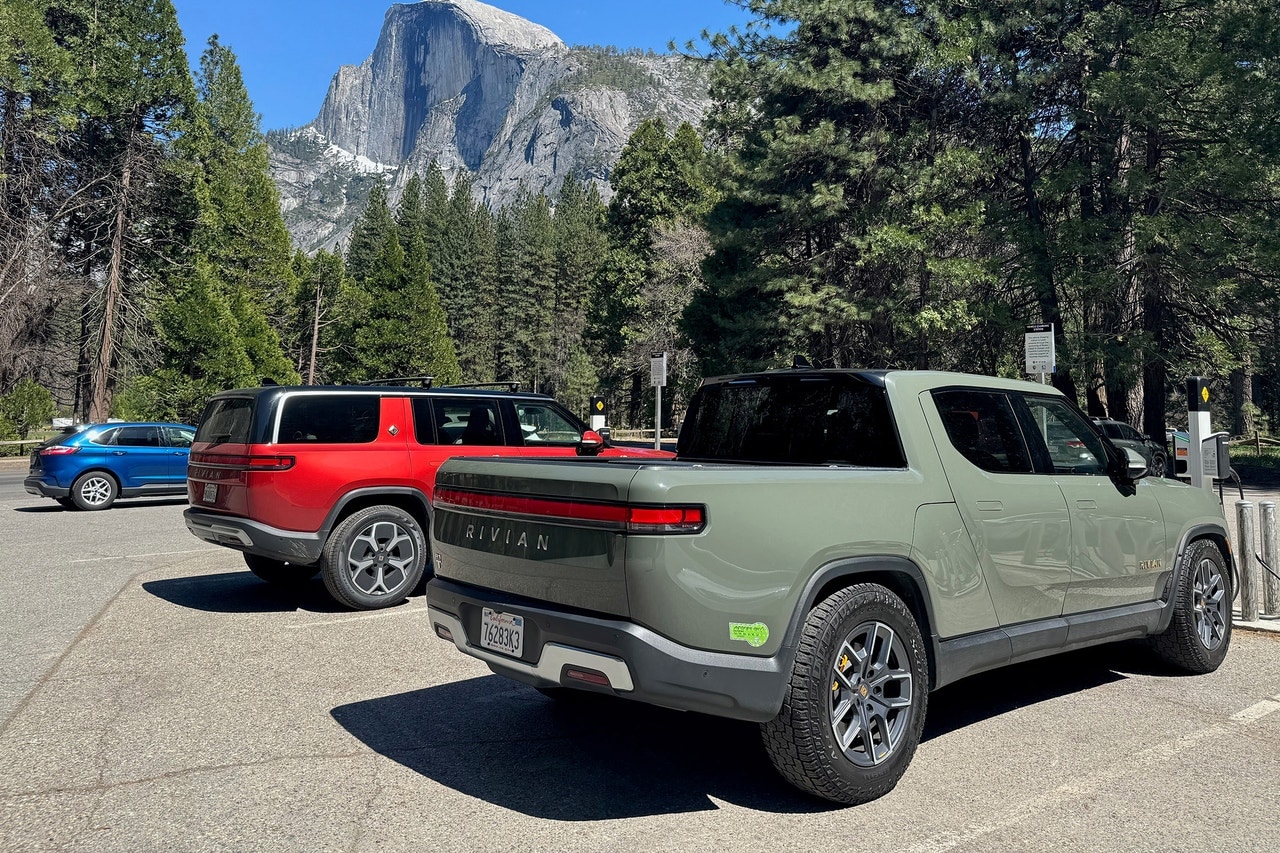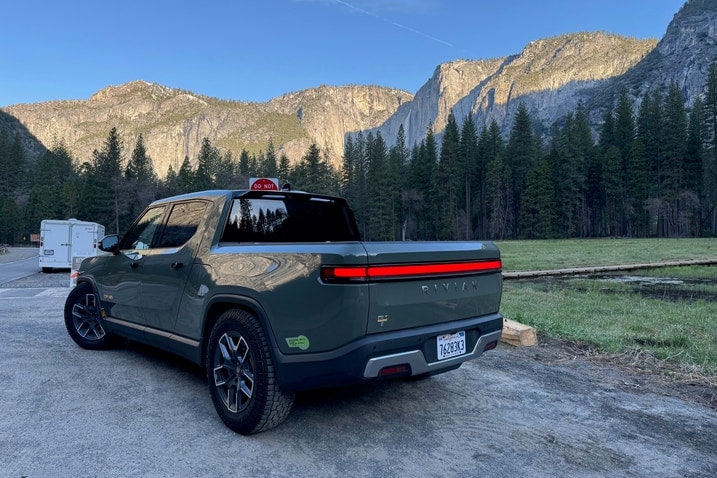- The Rivian R1T looks like an ideal camping vehicle.
- But how does range anxiety affect a weekend camping trip?
- We put that, and Rivian's charging network, to the test.
Testing Rivian's Charging Network With Our Long-Term R1T
We took our R1T camping in Yosemite to test the company's Adventure Network
Perhaps more than any other truck, the Rivian R1T feels purpose-built for camping. It's not just the REI-chic design, although that's part of it. It's the bevy of nifty features ranging from the practical (gear tunnel) to the fun (camp speaker).
But if you suffer from range anxiety, the prospect of taking an all-electric pickup truck camping may not be your idea of a good time. Rivian seems to have anticipated this. The company says it's installing more than 10,000 Waypoint (Level 2) chargers in North America, many of them inside or around national parks.
At the time of this writing, Rivian has built 424 high-speed chargers at 70 sites and an unspecified number of Level 2 chargers. We didn't count them all, but it's fewer than 10,000. The upcoming migration to NACS and the new accessibility of Tesla's Supercharger network may be putting a dent in those plans.
I decided to put our range anxiety to rest for a weekend and took our long-term Rivian R1T to Yosemite National Park to try out the Rivian Adventure Network. My wife and I left before sunrise from Irvine, California, after plugging our campsite, North Pines, into the built-in navigation system. I was able to set our preferred methods of charging (high-speed, no sites that need adapters) and my preferred state of charge at arrival (50%, just in case). The built-in nav did everything else from there, scheduling a pair of charging stops in Bakersfield and Fresno and even including how long I could expect to charge at each of them.
How's the Rivian R1T's built-in navigation system?
I don't use the built-in navigation for local driving because I think both Apple and Google do a better job of finding quick routes, anticipating traffic, and offering alternatives when things go wrong. But using Rivian's navigation for a long road trip was great and nearly as good as Tesla's when it came to locating an available charging station. Rivian recently pushed through an update that offers charging grades for stations. The grades take into account speed and downtime to hopefully make it a bit easier to plan your trip.
The trip to Yosemite
Charging in Bakersfield at an EVgo station also served as my breakfast stop. The station disconnected from the R1T twice before I moved the vehicle to an adjacent station, which seemed to solve the problem. I was able to get up to 80% state of charge before rolling out to Fresno. That was another EVgo station — I spent about 30 minutes charging there without any issues. The navigation system, at this point, said I would comfortably make it to my campsite with a 50% state of charge.
That's probably true. But just in case, I decided to stop just outside the entrance to the park in Oakhurst for some lunch and a quick charge. This stop proved fruitful as I was able to get the R1T up to full charge in just over an hour. From there, I made the journey into Yosemite National Park — about 30 miles with lots of elevation changes.
This went off without a hitch and I made it to Curry Village, walking distance from my campsite, with a little more than 81% of the R1T's battery life remaining. But this was my first chance to try out Rivian's Waypoint chargers, which were open and available near the collection of shops in Curry Village.
How do Rivian's Waypoint chargers work?
It could not have been easier. I parked the truck, opened the charge port, and plugged it into one of the dozen charging stations in the parking lot. These stations are open to all electric vehicles and are currently free of charge. I saw Teslas, BMWs and Rivians during my two-night stay, but never felt like I needed to fight over a charging station. These are Level 2 chargers, though they appeared to be loading electrons quicker than a standard ChargePoint station. The R1T said it was charging at a rate of 20 miles per hour, which is pretty quick for a Level 2 charger.
That made my game plan pretty simple. I got up early the next morning, plugged the R1T into an available charger, and went on a handful of hikes over the next several hours. When I came back, the R1T's state of charge was in the low 90% range. I'd have no problem getting out of the park the next morning, so that concluded my in-park charging during the trip.
I didn't see any fast chargers inside the park, and while you probably don't need a full tank to enter the park, you shouldn't be running on empty either. I took care to tell the R1T to sleep when I was at the campsite to help prevent it from draining its battery by looking for a cell network that didn't exist. Otherwise, I didn't notice any significant battery drain while it was parked — and it felt like I was constantly in and out of the back seat to either grab gear or put it away.
How is the Rivian R1T as a camping vehicle?
The R1T is very nice on a camping trip. With the tonneau cover still broken (it's stuck in an almost closed state) and no tie-downs handy, I stored all my gear in the back seat, the gear tunnel and the frunk. This worked flawlessly. When I got to the campsite, I moved much of my gear into the bear locker at the campsite while leaving a few non-food items inside the truck for easy access. I used the electric outlets in the bed to charge my phone and boil water using an electric kettle.
On my journey back to Irvine, I made only one stop in Buttonwillow, California, at a Rivian Adventure Network station. It worked much like a Tesla Supercharger station. You plug in your Rivian (these stations are currently only compatible with Rivians) and the charger uses the payment info already stored in the Rivian app. I was able to get close to a full charge while eating lunch and, from there, made it back to Irvine with around 30% state of charge.
Talk to me about the camp speaker
The camp speaker sits underneath the center console — below the pullout cupholders. You can unlock the camp speaker using the central screen and then pair your music-playing device (in my case, an iPhone 15) with it. There are a series of buttons on the speaker that are quasi-intuitive. I had to mess around with it a bit to get a sense of which button changed the volume and which skipped tracks, but eventually you'll get the hang of it. I'm no audiophile, but the sound was about what I'd expect for a portable speaker.
It got loud enough that I could hear it around our campsite, but out of courtesy for my neighbors I refrained from cranking it all the way up. This is one of the R1T's nice-to-have but not got-to-have features. I really enjoyed using it, particularly because I don't own a similar device. But if you're already got a Bluetooth speaker that you prefer to bring camping, the utility might be limited.
Is the Rivian R1T the best truck for camping?
Camping with the R1T clearly took more planning and time than if I used a similar gas-powered truck. It's possible that I could have made the entire round-trip journey to Yosemite from Irvine without ever putting gas in the vehicle. But if you want an electric truck and you love camping, the Rivian R1T is a great choice. Its nifty suite of features and ample interior storage make packing, unpacking and repacking a breeze. Recent software updates have also greatly improved the ride quality, making road trips far more pleasant.
Edmunds says
The Rivian R1T is a great vehicle for camping, so long as you're willing to do the extra planning to make it happen.










 by
by  edited by
edited by